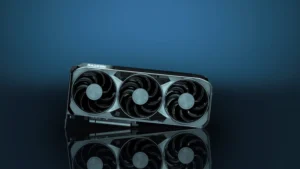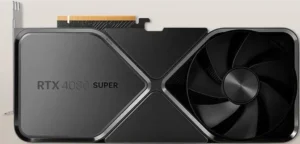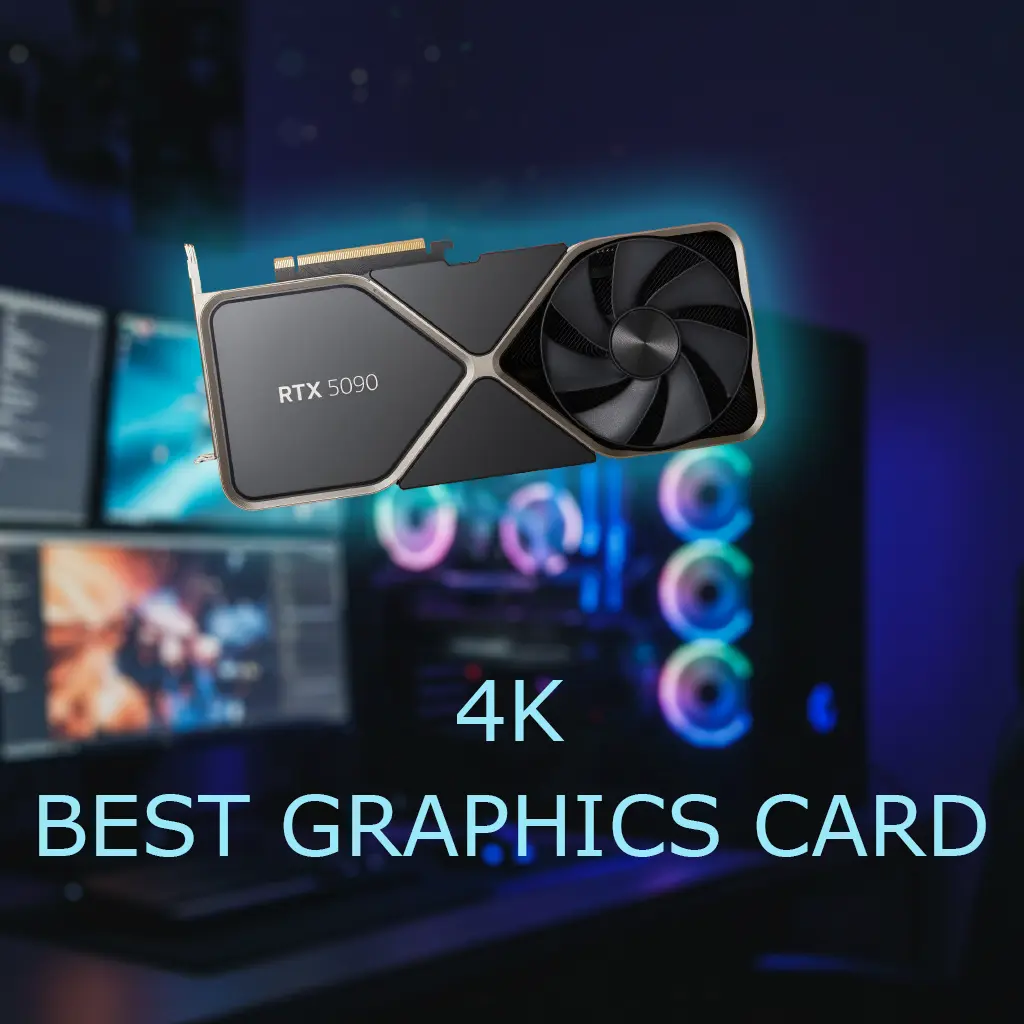Alright, so it’s 2025, and let’s be honest, if you’re serious about PC gaming, 4K resolution is pretty much the holy grail. Those super sharp monitors with tons of pixels are way more common now, and that means everyone wants graphics cards that can really make games shine at this level. Think of it this way: 4K (that’s 3840 x 2160 pixels) is like getting a massive upgrade in picture quality compared to something like 1440p. Everything looks so much clearer and more detailed – it’s a real treat for the eyes!
But here’s the thing: all those extra pixels need a lot of muscle to push around. Your graphics card has to work much harder to keep the game running smoothly, especially in the latest, most visually impressive titles.
That’s where this blog post comes in! We’re going to break down the best graphics cards you can get your hands on right now in 2025 for playing games in glorious 4K. We’ll take a look at the top contenders, what makes them tick, where they shine (and maybe where they don’t), and how they actually perform in games. Our goal is to give you the complete picture if you’re thinking about building a new gaming rig or just want to upgrade to the ultimate 4K experience.
Moving from 1440p to 4K is a big jump for your graphics card. It’s like asking it to draw almost double the amount of detail! So, naturally, the best graphics cards for 4K gaming are the top-of-the-line options from both Nvidia and AMD.
Plus, technologies like ray tracing (for super realistic lighting) and smart upscaling like DLSS 4 and FSR 4 have gotten really good. They play a huge part in making sure you can get smooth frame rates in 4K even in the most demanding games. So, we’ll definitely be looking at how well these graphics cards work with those technologies to give you the best recommendations for 4K gaming in today’s world.
Quick Look: The Top Graphics Cards for 4K Gaming in 2025
Based on current information and anticipated trends, several graphics cards stand out as the top choices for 4K gaming in 2025. These cards cater to different priorities, including overall performance, value, and brand preference.
The Best 4K Graphics Card Overall: Nvidia GeForce RTX 5090
The Nvidia GeForce RTX 5090 is the most powerful consumer GPU available in 2025. It offers a significant performance uplift compared to its predecessor, the RTX 4090. Key features include the next-generation DLSS 4 technology and an increase in video memory. The GPU runs RDR2 at 116 Fps and Horizon Forbidden West at 109 FPS on 4k Max graphics settings. As an average, it performed 41% faster than RTX 4090 at 4K.
The Best Value 4K Graphics Card: AMD Radeon RX 9070 XT or Nvidia GeForce RTX 5080
Defining “value” in the high-end 4K gaming segment is relative. The AMD Radeon RX 9070 XT is positioned as an excellent 4K graphics card that offers strong performance without the exorbitant price tag of the top-tier options. It is noted for its competitive pricing against the Nvidia GeForce RTX 5070 Ti and its “excellent 4K performance for the money”. A significant advantage for the RX 9070 XT is the inclusion of FSR 4, AMD’s latest AI-powered upscaling technology. On the other hand, the Nvidia GeForce RTX 5080 is also a strong contender for value, delivering a “next-gen 4K punch” with the benefit of DLSS 4 capabilities. It is considered to be “nearly unopposed at this price point” and offers a compelling balance of high-end performance at a slightly more accessible price than the RTX 5090. Both of these cards represent strong value propositions within the context of premium 4K gaming.
The 2nd Best High-Performance Nvidia 4K Graphics Card: Nvidia GeForce RTX 4080 Super (Because of availability)
As previously mentioned, the Nvidia GeForce RTX 5090 is a top-performing Nvidia card for 4K gaming in 2025. However, the availability of the RTX 50 series is limited, the Nvidia GeForce RTX 4080 Super will remain a relevant high-performance option. The RTX 4080 Super boasts an improved price point compared to the original RTX 4080 and delivers strong ray-tracing performance. Even with the introduction of the RTX 50 series, the RTX 4080 Super continues to be a potent choice for 4K gaming, offering a good balance of performance and a more attainable price compared to the absolute top-tier cards.
The Best High-Performance AMD 4K Graphics Card: AMD Radeon RX 7900 XTX
The AMD Radeon RX 7900 XTX is the top-performing AMD GPU currently available and is a strong contender for 4K gaming in 2025. It offers robust rasterization performance and a substantial 24GB of VRAM, which can be advantageous in certain demanding games. The RTX 7900 XTX beats the Nvidia RTX 3090 Ti with 13+ Avg fps at 4k and almost matches the performance of the Nvidia RTX 4080 while in games like Ghost of Tsushima, Alan Wake 2, Hogwarts Legacy, Forza Horizon 5 it beats the RTX 4080 Super with 5-12% better performance.
Detailed Reviews of the Best 4K Graphics Cards
1. Nvidia GeForce RTX 5090 – Top Tier Nvidia GPU for 4K

The RTX 5090 features a significant increase in shaders compared to the RTX 4090, exceeding 21,760. The boost clock is around 2407 MHz. It is equipped with 32 GB of GDDR7 memory, offering a massive 1.79 TB/s memory bandwidth. The total graphics power (TGP) is approximately 575 W.
Reasons to Buy
We’re seeing it absolutely crush the latest games, easily pushing over 150 frames per second at a full 4K resolution with all the graphics settings maxed out. In one specific test, it even averaged around 149 frames per second without using DLSS or any frame-generation tricks. That’s some serious raw power!
Reasons to Avoid
The primary drawback of the RTX 5090 is its high price point, representing a significant increase over the launch price of the RTX 4090. Some users have reported coil whine issues with certain power supply units. The card also has high power demands, requiring a robust power supply and adequate cooling. Initial stock availability has been limited since launch.
4K Gaming Performance Analysis
The RTX 5090 delivers a 30% performance increase over the already formidable RTX 4090, providing exceptional frame rates at maximum settings in most 4K games in 2025. Benchmarks show impressive performance in demanding titles like Ghost of Tsushima, where it achieves 116 FPS at 4K compared to the RX7900 XTX 66 FPS, and Forza Horizon 5, where it surpasses 180 FPS with an average of 114 FPS against the RX7900XTX. Its ability to handle ray tracing at 4K is top-tier, further enhanced by the advanced AI capabilities of DLSS 4. The substantial performance lead of the RTX 5090 over its predecessor ensures a premium and smooth gaming experience at 4K resolution with the highest visual settings in the vast majority of games released in 2025.
Nvidia GeForce RTX 5080 – Best Graphics card for 4K gaming

Specifications: The Nvidia GeForce RTX 5080 features approximately 10,752 CUDA cores with a boost clock of around 2617 MHz. It comes with 16GB of faster GDDR7 memory on a 256-bit bus. The memory bandwidth is significantly higher than the RTX 4080 Super thanks to the GDDR7 memory. The TDP is around 360W.
Reasons to Buy: The RTX 5080 delivers excellent frame rates in 4K gaming, especially when using DLSS 4. The Founders Edition features an improved design with more efficient cooling. The faster GDDR7 VRAM contributes to its strong performance. It stands as a high-end card that is nearly without competition at its price point, making it a strong value for high-performance 4K gaming.
Reasons to Avoid: While powerful, the native performance of the RTX 5080 is more modest compared to the top-tier RTX 5090. Some users might be disappointed that it retains 16GB of VRAM, which could potentially become a limitation in very demanding future titles at 4K resolution. It is also on the pricier side, although more affordable than the RTX 5090.
4K Gaming Performance Analysis: The RTX 5080 provides a significant “next-gen 4K punch,” making it a very capable card for high-resolution gaming. It outperforms the previous generation RTX 4080 Super in most scenarios. Benchmarks directly comparing the RTX 5080 to the RTX 4080 Super and AMD Radeon RX 7900 XTX clearly tell that the RTX 5080 handles 4K gaming smoothly in the majority of titles. In the most demanding games, achieving maximum settings at a consistent 60+ FPS might require some adjustments or the use of DLSS 4. Overall, the RTX 5080 is a strong contender for gamers seeking high-end 4K performance without the absolute top-tier price of the RTX 5090.
AMD Radeon RX 9070 XT – Best Budget 4K Graphics card

Specifications: The AMD Radeon RX 9070 XT features around 4096 stream processors with a boost clock of approximately 2970 MHz. It is equipped with 16GB of GDDR6 memory on a 256-bit bus, offering a memory bandwidth of around 664.6 GB/s. It requires two 8-pin power connectors and features outputs, including HDMI 2.1b and DisplayPort 2.1a.
Reasons to Buy: The RX 9070 XT is highlighted for its “excellent 4K performance for the money,” offering a more affordable entry point into high-resolution gaming. A key advantage is the inclusion of FSR 4, which brings AI-powered upscaling to the AMD ecosystem. In testing, the RX 9070 XT outperforms the Nvidia GeForce RTX 5070 Ti in various games.
Reasons to Avoid: One potential drawback of the RX 9070 XT is that its ray tracing performance can sometimes fall behind that of comparable Nvidia cards. Additionally, its performance can vary significantly depending on the specific game being played.

4K Gaming Performance Analysis: The RX 9070 XT is a strong performer in rasterization at 4K resolution, often surpassing the RTX 5070 Ti in non-ray-traced games. Benchmarks in titles like Dragon’s Dogma 2 at 4K show the RX 9070 XT achieving an average of 70 FPS, positioning it between the RTX 4080 and RTX 3090 Ti. The RTX 5080 is definitely much faster than the RX 9070 XT, but in games like Ghost of Tsushima, Star Field, Forza Horizon 5, Microsoft Flight Simulator, and Horizon Forbidden West, the RX 9070 XT gives tough competition to the RTX 5080. But overall, the RTX 5080 is 18% faster in 4k gaming. The AMD RX 9070 XT proves itself as the best budget 4K Gaming GPU and overall best 1440p high refresh rate gaming card. This indicates that it delivers smooth gameplay in many demanding titles at high settings. However, its ray tracing capabilities might not be as robust as those of its Nvidia competitors. The RX 9070 XT appears to be an attractive option for gamers who prioritize strong traditional rendering performance at 4K and are looking for a more budget-conscious choice within the high-end segment.
Nvidia GeForce RTX 4080 Super

Specifications: The Nvidia GeForce RTX 4080 Super features 10240 CUDA cores with a boost clock of around 2610 MHz. It is equipped with 16GB of GDDR6X memory on a 256-bit bus, providing a memory speed of 23 Gbps and a bandwidth of 736 GB/s. The TGP is rated at 320W, and it typically requires a single 16-pin power connector. Display outputs include one HDMI 2.1a and three DisplayPort 1.4a ports.
Reasons to Buy: The RTX 4080 Super is the second-fastest overall GPU in the previous generation and offers a significant price reduction compared to the original RTX 4080. It delivers exceptional ray-tracing performance and provides mild performance improvements over its predecessor. It also benefits from all the usual Nvidia features, including DLSS 3 with Frame Generation.
Reasons to Avoid: While a price reduction, the base price of $999 is still considered expensive by many. The performance gains over the original RTX 4080 are relatively small. It utilizes the same AD103 GPU and 16GB VRAM as the RTX 4080. Some reviews noted that it can run a bit warm under load.
4K Gaming Performance Analysis: The RTX 4080 Super offers a compelling blend of high-end performance for 4K gaming. It generally outperforms the AMD Radeon RX 7900 XTX in many titles, especially those with ray tracing enabled. In Cyberpunk 2077 at 4K with Ultra settings and ray tracing, the RTX 4080 Super achieves playable frame rates, especially with DLSS 3 and Frame Generation enabled, going from an unplayable 16 FPS at native 4K to a smooth 67 FPS with DLSS 3. Its strong ray-tracing capabilities make it an excellent choice for gamers who prioritize visual fidelity. The RTX 4080 Super provides a top-tier 4K gaming experience and remains a strong contender even with the anticipated release of newer generation cards.
AMD Radeon RX 7900 XTX – Best AMD 4K Graphics card

Specifications: The AMD Radeon RX 7900 XTX features 6144 stream processors with a boost clock of up to 2500 MHz and a game clock of 2300 MHz. It is equipped with 24GB of GDDR6 memory on a 384-bit bus, offering a memory bandwidth of up to 960 GB/s. The typical board power is 355W and it requires two 8-pin power connectors. Display outputs include one HDMI 2.1, two DisplayPort 2.1, and one USB Type-C port.
Reasons to Buy: The RX 7900 XTX is the best-performing AMD GPU currently available, offering a significant performance increase over the previous generation. It often competes with or even outperforms the Nvidia GeForce RTX 4080 in rasterization performance and boasts a large 24GB VRAM capacity. It is also competitively priced compared to its Nvidia counterparts.
Reasons to Avoid: While powerful, the ray tracing performance of the RX 7900 XTX is generally not as strong as that of Nvidia’s high-end cards. It lacks Nvidia’s DLSS technology, relying on AMD’s FSR, which is sometimes considered less refined. Some users have reported potential driver issues and stability problems with this card.
4K Gaming Performance Analysis: The RX 7900 XTX delivers excellent performance in 4K gaming, particularly in titles where rasterization is the primary factor. It can often match or even exceed the frame rates of the RTX 4080 Super in such games. However, in games with heavy ray tracing implementation, the RX 7900 XTX typically falls behind Nvidia’s offerings. For example, in Cyberpunk 2077 at 4K with Ultra settings and ray tracing, the RX 7900 XTX achieves lower frame rates compared to the RTX 4080 Super. Despite this, it still provides a very capable 4K gaming experience, and its large VRAM can be beneficial in games with high texture demands. The RX 7900 XTX remains a strong choice for gamers who prioritize rasterization performance and value, especially if ray tracing is not their primary concern.
Comparison of Top 4K Graphics Card Specifications
| Specification | Nvidia GeForce RTX 5090 | Nvidia GeForce RTX 5080 | AMD Radeon RX 9070 XT | Nvidia GeForce RTX 4080 Super | AMD Radeon RX 7900 XTX |
| GPU Architecture | Blackwell 2.0 | Blackwell 2.0 | RDNA 4 | Ada Lovelace | RDNA 3 |
| CUDA Cores / Stream Processors | 21760 | 10752 | 4096 | 10240 | 6144 |
| Base Clock (MHz) | 2017 | 2295 | 1660 | 2295 | 1929 |
| Boost Clock (MHz) | 2407 | 2617 | 2970 | 2550 | 2498 |
| Memory Size (GB) | 32 | 16 | 16 | 16 | 24 |
| Memory Type | GDDR7 | GDDR7 | GDDR6 | GDDR6X | GDDR6 |
| Memory Bandwidth (GB/s) | 1790 | 960 | 644.6 | 736.3 | 960 |
| TDP (W) | 575 | 360 | 304 | 320 | 355 |
| Display Outputs | 3xDP 2.1b, 1xHDMI 2.1b | 3x DP 2.1b, 1x HDMI 2.1b | 3x DP 2.1a, 1xHDMI 2.1b | 3x DP 1.4a, 1x HDMI 2.1 | 2x DP 2.1, 1x HDMI 2.1a, 1x USB-C |
The Ultimate Guide to Choosing Your 4K Gaming Graphics Card: FAQs
How much VRAM do I need for 4K gaming in 2025? For 4K gaming in 2025, particularly with high settings and texture packs, 16GB of VRAM is generally considered the minimum, with 24GB offering more headroom for the most demanding titles. While 16GB cards like the RTX 5080 and RTX 4080 Super are still excellent for 4K, the 24GB found in the RX 7900 XTX and potentially higher amounts in future cards like the RTX 5090 provide a degree of future-proofing.
Is ray tracing important for 4K gaming? Ray tracing significantly enhances visual fidelity by simulating realistic lighting and reflections. By 2025, it is expected to be a more prevalent feature in games. If you prioritize the most visually immersive experience, a card with strong ray tracing capabilities, such as those from Nvidia, would be beneficial. However, if you are less concerned with ray tracing or primarily play games where it is not a major feature, AMD cards offer excellent rasterization performance at 4K.
Do I need a powerful CPU to pair with a high-end 4K graphics card? While the graphics card is the primary driver for 4K gaming performance, a capable CPU is still necessary to avoid bottlenecks. High-end cards like the RTX 5090 can be limited by weaker CPUs, even at 4K in some less GPU-intensive games. A modern high-core-count CPU from either Intel or AMD is recommended to ensure optimal performance.
What power supply wattage should I have? The required power supply wattage depends on the specific graphics card and the rest of your system components. The RTX 5090 is expected to have a high power draw of around 575W, suggesting a need for an 850W or even 1000W PSU. The RTX 5080 and RX 7900 XTX typically require an 800W or 850W PSU. The RTX 4080 Super has a TDP of 320W, with manufacturers generally recommending an 850W PSU for safety. It is always advisable to have some headroom above the recommended wattage.
What is the difference between DLSS and FSR, and which is better for 4K? DLSS (Deep Learning Super Sampling) is Nvidia’s proprietary AI-based upscaling technology, while FSR (FidelityFX Super Resolution) is AMD’s open-source spatial upscaling technology. By 2025, both are expected to have evolved significantly. DLSS 4 is anticipated to further improve image quality and performance, often considered superior in visual fidelity in many current implementations. However, FSR 4 is also expected to offer significant advancements and has the advantage of wider compatibility across different GPUs. For 4K gaming, both technologies can be crucial for achieving higher frame rates without a significant loss in visual quality.
What are the expected prices for these graphics cards in 2025? While MSRPs can provide a baseline, actual market prices in 2025 will depend on various factors, including supply and demand. Based on current information, the RTX 5090 is expected to be the most expensive, likely exceeding the RTX 4090’s launch price of $1599. The RTX 5080 is projected to be around the $999 mark. The AMD Radeon RX 9070 XT is positioned as a more budget-friendly option at around $599. The RTX 4080 Super has an MSRP of $999. The RX 7900 XTX launched at $999 but its price may fluctuate in 2025. It’s important to monitor market trends closer to the purchase date.
Factors to Consider When Buying a 4K Graphics Card in 2025
Choosing the right 4K graphics card in 2025 involves considering several key factors beyond just raw performance.
Budget: While this report focuses on high-end options, there will likely be a range of graphics cards capable of 4K gaming at different price points. Determine your budget and then look for the best performing card within that range.
Performance Goals: Consider the specific games you play and your desired frame rates and detail levels. If you aim for ultra settings and high refresh rates in demanding titles, you will need one of the top-tier cards.
Ray Tracing Preference: If you value realistic lighting and reflections and play games that heavily utilize ray tracing, prioritize Nvidia cards known for their strong ray tracing performance.
Upscaling Technology: Decide whether you have a preference for Nvidia’s DLSS or AMD’s FSR ecosystem. Both are valuable for 4K gaming, but their performance and image quality can vary between games.
Monitor Specifications: Ensure your 4K monitor has a sufficient refresh rate (ideally 120Hz or higher) to take full advantage of the high frame rates these cards can deliver. Also, consider features like variable refresh rate (FreeSync or G-Sync).
System Compatibility: Verify that your power supply unit meets the requirements of your chosen graphics card. Also, ensure your PC case has enough physical space to accommodate the card, as high-end GPUs can be quite large. Be mindful of potential CPU bottlenecks, especially with the most powerful cards.
Future-Proofing: Consider how long you plan to use the graphics card and whether you want it to be capable of handling upcoming games with demanding graphical requirements. Higher VRAM and newer architectures tend to offer better future-proofing.
Availability and Pricing: The hardware market can be dynamic, with prices and availability fluctuating. Keep an eye on reviews and retailer listings closer to your purchase date to get the most up-to-date information.
Conclusion
Okay, looking ahead to 2025, if you’re dreaming of incredible 4K gaming, you’re in for a treat! We’re expecting some seriously powerful graphics cards from both Nvidia and AMD that will make your games look absolutely stunning. Nvidia’s GeForce RTX 5090 is shaping up to be the absolute top dog, promising a huge jump in performance compared to what we have now.
If you’re looking for something that gives you amazing 4K visuals without breaking the bank quite as much, keep an eye on the AMD Radeon RX 9070 XT and the Nvidia GeForce RTX 5080. They look like fantastic options that could be a bit easier on your wallet.
Don’t count out the Nvidia GeForce RTX 4080 Super either – it’s still a great choice, especially if you love those realistic lighting effects from ray tracing. And AMD’s Radeon RX 7900 XTX is still a beast for raw power and has a ton of memory (VRAM), which is great for smooth gameplay.
Ultimately, picking the right graphics card for you comes down to a few things: how much you want to spend, how amazing you want your games to look and run, and whether you have a preference for certain features or technologies. So, take a good look at what’s out there, think about what matters most to you, and you’ll be well on your way to having an awesome 4K gaming setup in 2025!


